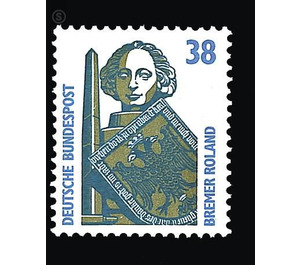Postage stamp: sights - Germany / Federal Republic of Germany 1989 - 38 Pfennig
Theme: Art & Culture
| Country | Germany / Federal Republic of Germany |
| Issue Date | 1989 |
| Face Value | 38.00 |
| Color | brown white blue |
| Perforation | K 14 |
| Printing Type | indirect 2-color letterpress |
| Stamp Type | Postage stamp |
| Item Type | Stamp |
| Chronological Issue Number | 1273 |
| Chronological Chapter | GER-BRD |
| SID | 619397 |
| In 30 Wishlists | |
With »Landmarks«, the Deutsche Bundespost replaces the series »Castles and Palaces«, begun in 1976/77. The new permanent series with its extraordinary representations of significant cultural and technical achievements out, but should also be an incentive to look at the objects once in the original. Of the new role brands - they appear at the same time and continue the series - the 20 Pf and the 140 Pf value will be identical in the issues »Deutsche Bundespost Berlin«, the 33 Pf and the 38 Pf value only published in the issue »Deutsche Bundespost«. The Bremer Roland is 5.55 meters high, from the canopy to the base foot is 10.21 meters. The imposing figure stands for law and freedom as well as for the independence of the Free Hanseatic City of Bremen. "I proclaim freedom to you, which Karl and many other princes have indeed given to this city. For that, thank God, this is my advice, "reads the inscription, translated into High German, on Roland's shield. He also shows an old German national emblem, the double-headed imperial eagle of the Viennese emperor. The relationship of Bremer Roland to the legendary figure from the circle of Charlemagne is unclear. After the Old French Roland song Count Hruotland from Brittany was the most outstanding of the twelve paladins of the Frankish king and later Emperor Charles. Hruotland fell in 778 in a battle against the Basques in the valley of Roncevalles. Other versions as interpretation attempts for the name Roland: rode land (cleared land) or red soil as a place of the Femegerichtes. In any case, the stone figure is a legal and market symbol. It symbolizes the privileges that were once given to the city. (Text: Press Office of the Senate of the Free Hanseatic City of Bremen)


